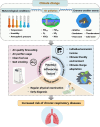Climate change, air pollution and chronic respiratory diseases: understanding risk factors and the need for adaptive strategies
- PMID: 39880611
- PMCID: PMC11790401
- DOI: 10.1265/ehpm.24-00243
Climate change, air pollution and chronic respiratory diseases: understanding risk factors and the need for adaptive strategies
Abstract
Under the background of climate change, the escalating air pollution and extreme weather events have been identified as risk factors for chronic respiratory diseases (CRD), causing serious public health burden worldwide. This review aims to summarize the effects of changed atmospheric environment caused by climate change on CRD. Results indicated an increased risk of CRD (mainly COPD, asthma) associated with environmental factors, such as air pollutants, adverse meteorological conditions, extreme temperatures, sandstorms, wildfire, and atmospheric allergens. Furthermore, this association can be modified by factors such as socioeconomic status, adaptability, individual behavior, medical services. Potential pathophysiological mechanisms linking climate change and increased risk of CRD involved pulmonary inflammation, immune disorders, oxidative stress. Notably, the elderly, children, impoverished groups and people in regions with limited adaptability are more sensitive to respiratory health risks caused by climate change. This review provides a reference for understanding risk factors of CRD in the context of climate change, and calls for the necessity of adaptive strategies. Further interdisciplinary research and global collaboration are needed in the future to enhance adaptability and address climate health inequality.
Keywords: Air pollution; Climate change; Extreme weather events; Respiratory health; Vulnerability.
Conflict of interest statement
The authors declare that they have no competing interests.
Figures
Similar articles
-
The potential impacts of climate variability and change on air pollution-related health effects in the United States.Environ Health Perspect. 2001 May;109 Suppl 2(Suppl 2):199-209. doi: 10.1289/ehp.109-1240667. Environ Health Perspect. 2001. PMID: 11359687 Free PMC article. Review.
-
Impact of climate change and air pollution on childhood respiratory health.J Pediatr (Rio J). 2025 Mar-Apr;101 Suppl 1(Suppl 1):S65-S69. doi: 10.1016/j.jped.2024.11.007. Epub 2025 Jan 31. J Pediatr (Rio J). 2025. PMID: 39701550 Free PMC article. Review.
-
The impact of air pollution on respiratory diseases in an era of climate change: A review of the current evidence.Sci Total Environ. 2023 Nov 10;898:166340. doi: 10.1016/j.scitotenv.2023.166340. Epub 2023 Aug 15. Sci Total Environ. 2023. PMID: 37591374 Review.
-
Climate change, extreme weather events, air pollution and respiratory health in Europe.Eur Respir J. 2013 Sep;42(3):826-43. doi: 10.1183/09031936.00074712. Epub 2013 Jan 11. Eur Respir J. 2013. PMID: 23314896 Review.
-
Climate change, air pollution, and allergic respiratory diseases: a call to action for health professionals.Chin Med J (Engl). 2020 Jul 5;133(13):1552-1560. doi: 10.1097/CM9.0000000000000861. Chin Med J (Engl). 2020. PMID: 32590458 Free PMC article.
References
-
- Wu X, Lu Y, Zhou S, Chen L, Xu B. Impact of climate change on human infectious diseases: Empirical evidence and human adaptation. Environ Int. 2016;86:14–23. - PubMed
-
- Filonchyk M, Peterson MP, Zhang L, Hurynovich V, He Y. Greenhouse gases emissions and global climate change: Examining the influence of CO(2), CH(4), and N(2)O. Sci Total Environ. 2024;935:173359. - PubMed


